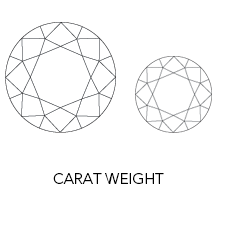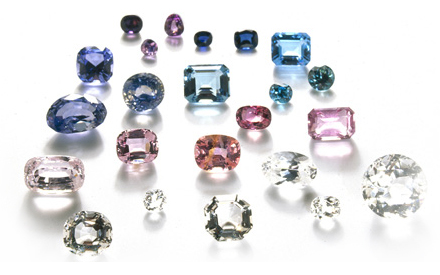 The closer a diamond is to being flawless, i.e free from internal characteristics called ‘inclusions’ and external characteristics called ‘blemishes’, the higher its value.
The closer a diamond is to being flawless, i.e free from internal characteristics called ‘inclusions’ and external characteristics called ‘blemishes’, the higher its value.
Clarity of a diamond is assessed using a scale of six categories which refer to the amount and severity of the inclusion, starting at Flawless (FL) and ending at Included (I). Grading the clarity involves determining the number, size, relief, nature, and position of these characteristics, as well as how these affect the overall appearance of the stone. For example a stone could have quite a large “feather” inclusion which is white in colour and on the underside of the stone, or it could have a very small black inclusion right in the centre of the table (top facet). This would affect the value of the diamond far more.
Many inclusions are too tiny to be seen by anyone other than a trained diamond grader. To the naked eye, a “Very Slightly” included stone (VS) and a “Slightly Included” (SI) diamond may look exactly the same, but these diamonds are quite different in terms of overall quality.
 The colour evaluation of most diamonds is based on the absence of colour. A chemically pure and structurally perfect diamond has no hue and consequently, a higher value. The industry’s most widely accepted grading system is a scale begining with the letter D, representing colourless, and continues along the alphabet, with increasing presence of colour, to the letter Z.
The colour evaluation of most diamonds is based on the absence of colour. A chemically pure and structurally perfect diamond has no hue and consequently, a higher value. The industry’s most widely accepted grading system is a scale begining with the letter D, representing colourless, and continues along the alphabet, with increasing presence of colour, to the letter Z.
Many of these colour distinctions are so subtle that they are invisible to the untrained eye; however, these distinctions make a very big difference in diamond quality and price. A diamond will be faint yellow in the middle of the scale and is often undesirable as it is neither white nor yellow however as it approaches the lower end it becomes a stronger in colour.
This is then known as a fancy yellow diamond with a distinct hue and consequently desirable again.
 A carat weight is the measurement of how much a stone weighs.
A carat weight is the measurement of how much a stone weighs.
Each carat can be divided into 100 ‘points’. For example a diamond may weigh 0.33 points, or 1/3rd of a carat, and can also be referred to as a “33 Pointer”. Once reaching 100 points a stone is then referred to as 1ct. 133points is referred to as 1.33cts etc.
Often a diamond will increase in value with the carat weight, because larger diamonds are rarer and more desirable. However two diamonds of equal carat weight can have very different values depending on the other 3 C’s: Clarity, Colour, and Cut.
 A diamonds’ cut is both the shape of the diamond and the craftsmanship of the cut, it is crucial to the stone’s final beauty and value. All gemstones can be cut into a variety of shapes, the most popular being the round brilliant cut – known as the ‘brilliant’ cut because it produces the optimum light and sparkle from a diamond. Each brilliant stone has 52 facets, each facet reflecting light from one to the other and eventually back out the top of the stone to our eye which is why we get that all-desirable sparkle.
A diamonds’ cut is both the shape of the diamond and the craftsmanship of the cut, it is crucial to the stone’s final beauty and value. All gemstones can be cut into a variety of shapes, the most popular being the round brilliant cut – known as the ‘brilliant’ cut because it produces the optimum light and sparkle from a diamond. Each brilliant stone has 52 facets, each facet reflecting light from one to the other and eventually back out the top of the stone to our eye which is why we get that all-desirable sparkle.
In my micro-pave set jewellery every minute diamond I use is a true brilliant-cut stone, each has 52 facets resulting in a line or sea of diamond sparkle that can simply not be achieved from one large stone.
The craftsmanship of the cut takes into account its weight relative to its diameter, its girdle thickness (which affects its durability), the symmetry of its facets, and the quality of polish on those facets. The proportions of the facets influence what the diamond looks like “face-up” , i.e. what we see when the stone is mounted in a piece of jewellery, and are key to bringing out the optimum beauty of a stone. Diamond Cut Scale is certified as 5 grades from Excellent down to Poor.
CHOOSING A COLOURED STONE
A coloured stones’ rarity, depth of colour and provenance all have a relationship to its quality and value. The 4 C’s detailed above, most importantly colour, should also be considered when choosing coloured gemstones. There are issues of colour enhancement, oiled and resin filled stones, all of which are important to be aware of. Conventional wisdom suggests that quality should be valued over quantity; a large stone of low quality will look significantly less impressive on examination than a small stone of high quality.
Through many years of experience Jessica uses only beautiful top grade diamonds and gemstones. She can source coloured stones from ethical and fairly traded companies and ensures that all diamonds are purchased from trusted suppliers who guarantee a conflict free source and support the guidelines of the Kimberly Process. Jessica studied with the Gemmological Association of Great Britain (Gem-A) and was awarded a qualification in gem identification and handling. When choosing any gemstone Jessica will help guide and inform you during your decision making.


